
An American man is accused of going on a religiously motivated rampage at the Israel Museum in Jerusalem, smashing two ancient Roman sculptures in the archaeology wing before being stopped by security guards and arrested by Israeli police.
The suspect has been identified as a 40-year-old Jewish American tourist, dressed in religious garb. His name is being withheld while he undergoes psychiatric evaluation.
Authorities were called to the scene because he was “deliberately smashing and breaking statues of great value,” inflicting “great damage,” police told Haaretz. He attacked the sculptures “because he believes the statues go against the Torah” and were “blasphemous.” (The second of the Ten Commandments states that “Thou shalt not make unto thee any graven image.”)
“This is a shocking case of the destruction of cultural values,” Eli Escusido, director of the Israel Antiquities Authority, said in a statement, as reported by Israeli news website Ynet News. “We see with concern the fact that cultural values are being destroyed by religiously motivated extremists.”
One of the vandalized sculptures at the Israel Museum. Photo courtesy of the Israel Museum, Jerusalem.
Nick Kaufman, a lawyer representing the suspect, argued during a remand hearing that this was not a case of religious fanaticism, but that his client was suffering from so-called Jerusalem syndrome, the Associated Press reported. The mental disorder is said to occur when tourists and religious pilgrims visiting the city—sacred in the Jewish, Christian, and Muslim faiths—and begin to have religiously obsessive ideas. The most common symptom of the psychosis is believing that one is actually a figure from the Bible.
Both damaged artworks, which the suspect reportedly knocked to the floor by toppling their pedestals, date to the 2nd century C.E. The first was Head of Athena, a marble head that originally would have been brightly painted, and part of a full body figure of the goddess. The second, which sustained more extensive damage based on photographs, is Griffin grasping Nemesis’s wheel of fate, representing the Roman goddess of fate and revenge.
The museum plans to restore both works in its conservation department. It has not released estimates as to the cost of the damage.
The vandalism was a “severe incident” and a “troubling and unusual event,” the Israel Museum said in a statement provided to Newsweek, noting that the institution “condemns all forms of violence and hopes such incidents will not recur.”
The museum reopened Friday morning, and will be operating as normal this weekend.